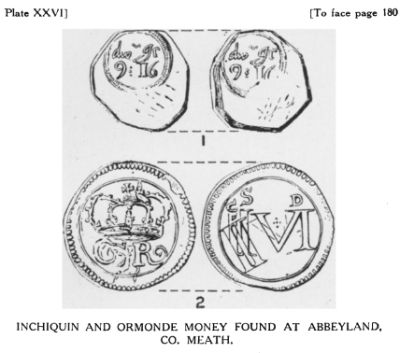Abbeyland Hoard
Treasure Trove find in Co. Meath, Ireland
On the 17th or 18th of June 1921, a number of finds were found in a crock, when a ditch was being cleaned a Abbeylands, Navan, Co. Meath. Some fragments of the crock and 29 of the coins, obtained as treasure trove, were forwarded by the authorities to the Royal Irish Academy.
The fragments of the vessel are too small to enable its shape to be determined: it was black glazed, probably dating to the late seventeenth century. The coins are all silver, in poor condition. I identified them as an English shilling of Edward VI., four shillings, and fifteen sixpences of Elizabeth; two shillings of James I., one half crown, five shillings and one sixpence, of Charles I. Thus all the coins were English. The Royal Irish Academy selected the fragments of the vessel and seven of the coins for their collection exhibited in the National Museum. The remainder will be returned to the authorities.
E. C. R. Armstrong, Vice-President.
The Journal of the Royal Society of Antiquaries of Ireland, Sixth Series, Vol. 11, No. 1, June 30th 1921, pp. 78-79.
Further Notes on the Coins discovered at Abbeylands, Navan, Co. Meath , in June 1921
Since the publication of my former note 445 additional coins belonging to this find have been recovered. The following is a list of these:-
One shilling, Edward V., mint mark, y; 2 sixpences, Edward CI., Tower and York mints; 2 English shillings and 2 English sixpences, Philip and Mary; 48 English shillings, Elizabeth, marks include, martlet, cross-crosslet, bell, escallop, hand, woolpack, 1 and 2; 177 English sixpences, Elizabeth, marks include, arrow, rose, lion, coronet, castle, ermine, cross, sword, bell, escallop, A, hand, ton, key, 1, star, woolpack; 42 English shillings, James I., marks include, thistle, lis, rose, escallop, coronet, bell, trefoil, ton; 4 Irish shillings James I., 1, first, three coinage; 23 English sixpences, James I., marks include, thistle, lis, rose, escallop, coronet; three thistle marks of James Vi., 2 dated 1601 and 1 dated 1062; 27 English half-crowns of Charles I., declaration type, dated 1645, A, below date; 74 English shillings of Charles I., marks include, lis, anchor, portcullis, bell, crown, ton, triangle, star, triangle in circle, (P), (R); 17 English sixpences, Charles I., marks include, rose, bell, ton, triangle in circle; 8 Irish coins, Charles I., i.e. Inchiquin money, 2 half-crowns, first, and 1 third issue; Ormonde money, 2 half-crowns and 3 sixpences; 8 Spanish "cob" dollars and 4 half-dollars; a much worn coin that appears to be a sixpence of Elizabeth struck on both sides with the Royal Arms (portion of the date ..82 can be seen above the shield); and an indistinguishable coin.
It will be noticed that of the 474 coins recovered, 12 only were Irish, i.e. the four shillings of James I., the Inchiquin and the Ormonde money. The remainder of the coins with the exception of the three Scottish thistle marks, and the Spanish dollars, were English.
The hoard includes coins separated in date by about a century. The latest and the type of vessel which contained them, give us a clue to the time when the hoard was buried. This appears to have been the end of the seventeenth century. Possibly the concealment was occasioned by the troubles that occurred in Ireland during the reign of James II.
It is interesting to note that the find of over 200 coins made in 1912, in another Abbeyland, near Castledermot Co. Kildare [1] included specimens dated from the reign of Edward VI., to Charles I.; also that in this find 9 coins only were Irish, the remainder including a number of Spanish "cob" dollars, and a Scotch coin of James VI. The 75 shillings and 2 half-crowns found at Camolin, Co. Wexford in 1913 also included coins of Edward VI., Elizabeth, James I and Charles I. As all these later coins were English, it is suggested that they represented, the accumulated pay of an Ehglish soldier, who had accompanied Cromwell's forces to Ireland, and who fell during the investiture of Wexford, shortly after the surrender of Drogheda in 1649. [2]

The most interesting coins discovered in the Navan find were the Inchiquin and Ormonde money. Of the former one 2s, 6d of the first issue appears to be of the same die as a specimen figured by Smith[3] now in the Royal Irish Academy's collection. The second coin of the first issue, which weighs 227 gm., is illustrated (Plate XXVI., Fig. 1); it is a variety unrepresented in the Academy's collection. The specimen of the third issue of the Inchiquin money is a duplicate of that figured by Smith[4] also in the Academy's collection. One of the Ormond 2/6's (weight 226.5 gr.) recovered through the good offices of Sir Nugent Everard, Bt., H.M.L. has been double struck (Plate XXVI., Fig. 2).
E.C.R. Armstrong. Vice President.
[1] Armstrong, Journal, ante, vol. xlii, p.70, also, Fitzgerald, Journal, Co. Kildare Archaeological Society, vol. vii, p.128, and MacIlwain, British Numismatic Journal, vol. ix, p. 317, 318.
[2] Francis, British Numismatic Journal, vol. x. p. 315-318.
[3] Journal, ante, vol. vi, plate, II, fig. 1.
[4] Ibid., plate 3, fig. 7.
The Journal of the Royal Society of Antiquaries of Ireland, Sixth Series, Vol. II, No. 2, Dec 31st 1921, pp. 179-180.